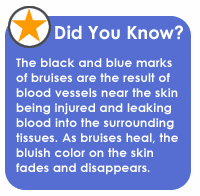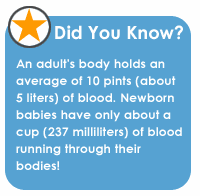
Just about everyone knows that we can't
live without blood. Without blood,
our organs couldn't get the oxygen and nutrients they need to
survive, we couldn't keep warm or cool off, we couldn't fight
infections, and we couldn't get rid of our own waste products.
Without enough blood, we'd weaken and die.
So how exactly does blood do these
things? How is it made, and what's in it? How does blood clot? These
questions and more are explained in this article about the
mysterious, life-sustaining fluid called blood.
What Is
Blood and What Does It Do?
 Two types of blood vessels carry blood throughout our bodies: The arteries carry
oxygenated blood (blood that has received oxygen from the lungs)
from the heart to the rest of the body. The blood then travels
through the veins back to the heart and lungs, where it receives
more oxygen. As the heart beats, you can feel blood traveling
through the body at your pulse points - like the neck and the wrist
- where large, blood-filled arteries run close to the surface of the
skin. Two types of blood vessels carry blood throughout our bodies: The arteries carry
oxygenated blood (blood that has received oxygen from the lungs)
from the heart to the rest of the body. The blood then travels
through the veins back to the heart and lungs, where it receives
more oxygen. As the heart beats, you can feel blood traveling
through the body at your pulse points - like the neck and the wrist
- where large, blood-filled arteries run close to the surface of the
skin.
The blood that flows through this
network of veins and arteries is called whole
blood. Whole blood contains three types of blood cells,
including:
- red blood cells
- white blood cells
- platelets
These three types of blood cells are
mostly manufactured in the bone marrow (the soft tissue inside our
bones), especially in the bone marrow of the vertebrae (the bones
that make up the spine), ribs, pelvis, skull, and sternum
(breastbone). These cells travel through the circulatory system
suspended in a yellowish fluid called plasma
(pronounced: plaz-muh). Plasma is 90% water and
contains nutrients, proteins, hormones, and waste products. Whole
blood is a mixture of blood cells and plasma.
Red blood cells (also called
erythrocytes, pronounced:
ih-rith-ruh-sytes) are shaped like slightly
indented, flattened disks. Red blood cells contain an iron-rich
protein called hemoglobin (pronounced:
hee-muh-glow-bun). Blood gets its bright red color
when hemoglobin in red blood cells picks up oxygen in the lungs. As
the blood travels through the body, the hemoglobin releases oxygen
to the tissues. The body contains more red blood cells than any
other type of cell, and each red blood cell has a life span of about
4 months. Each day, the body produces new red blood cells to replace
those that die or are lost from the body.
White blood cells (also called
leukocytes, pronounced:
loo-kuh-sytes) are a key part of the body's system
for defending itself against infection. They can move in and out of
the bloodstream to reach affected tissues. The blood contains far
fewer white blood cells than red cells, although the body can
increase production of white blood cells to fight infection. There
are several types of white blood cells, and their life spans vary
from a few days to months. New cells are constantly being formed in
the bone marrow.
Several different parts of blood are
involved in fighting infection. White blood cells called
granulocytes (pronounced:
gran-yuh-low-sytes) and
lymphocytes (pronounced:
lim-fuh-sytes) travel along the walls of blood
vessels. They fight germs such as bacteria and viruses and may also
attempt to destroy cells that have become infected or have changed
into cancer cells.
 Certain types of white blood cells produce
antibodies, special proteins that recognize foreign materials and
help the body destroy or neutralize them. When a person has an
infection, his or her white cell count (the number of cells in a
given amount of blood) often is higher than when he or she is well
because more white blood cells are being produced or are entering
the bloodstream to battle the infection. After the body has been
challenged by some infections, lymphocytes "remember" how to make
the specific antibodies that will quickly attack the same germ if it
enters the body again. Certain types of white blood cells produce
antibodies, special proteins that recognize foreign materials and
help the body destroy or neutralize them. When a person has an
infection, his or her white cell count (the number of cells in a
given amount of blood) often is higher than when he or she is well
because more white blood cells are being produced or are entering
the bloodstream to battle the infection. After the body has been
challenged by some infections, lymphocytes "remember" how to make
the specific antibodies that will quickly attack the same germ if it
enters the body again.
Platelets (also called
thrombocytes, pronounced:
throm-buh-sytes) are tiny oval-shaped cells made in
the bone marrow. They help in the clotting process. When a blood
vessel breaks, platelets gather in the area and help seal off the
leak. Platelets survive only about 9 days in the bloodstream and are
constantly being replaced by new cells.
Blood also contains important proteins
called clotting factors, which are critical to the
clotting process. Although platelets alone can plug small blood
vessel leaks and temporarily stop or slow bleeding, the action of
clotting factors is needed to produce a strong, stable clot.
Platelets and clotting factors work
together to form solid lumps to seal leaks, wounds, cuts, and
scratches and to prevent bleeding inside and on the surfaces of our
bodies. The process of clotting is like a puzzle with interlocking
parts. When the last part is in place, the clot happens - but if
only one piece is missing, the final pieces can't come
together.
When large blood vessels are severed
(or cut), the body may not be able to repair itself through clotting
alone. In these cases, dressings or stitches are used to help
control bleeding.
In addition to the cells and clotting
factors, blood contains other important substances, such as
nutrients from the food that has been processed by the digestive
system. Blood also carries hormones released by the endocrine glands
and carries them to the body parts that need them.
Blood is essential for good health
because the body depends on a steady supply of fuel and oxygen to
reach its billions of cells. Even the heart couldn't survive without
blood flowing through the vessels that bring nourishment to its
muscular walls! Blood also carries carbon dioxide and other waste
materials to the lungs, kidneys, and digestive system, from where
they are removed from the body.
An interesting thing about blood is
that blood cells and some of the special proteins blood contains can
be replaced or supplemented by giving a person blood from someone
else. This process is called a transfusion. In addition to receiving
whole blood transfusions, people can also receive transfusions of a
particular component of blood that they need. For example, a person
can receive only platelets, red blood cells, or a clotting factor.
When a person donates blood, the whole blood can be separated into
its different parts and used in this way.
Things That
Can Go Wrong With Blood
Most of the time, blood
functions without problems, but sometimes, blood disorders or
diseases can cause illness in children and teens. Diseases of the
blood that commonly affect children can involve any or all of the
three types of blood cells (red blood cells, white blood cells, or
platelets). Other types of blood diseases affect the proteins and
chemicals in the plasma that are responsible for
clotting.
Some of the diseases and
conditions involving the blood include:
Diseases of the Red Blood
Cells
The most common condition
affecting the red blood cells of children and adolescents is
anemia (pronounced:
uh-nee-mee-uh), a lower-than-normal number of red
cells in the blood. Anemia is accompanied by a decrease in the
amount of hemoglobin present in the blood. The symptoms of anemia -
such as pale skin, weakness, a fast heart rate, and poor growth in
infants and children - happen because of the blood's reduced
capacity for carrying oxygen. The causes of anemia can be grouped
into two main categories: those due to inadequate production of red
blood cells and those due to unusually rapid red blood cell
destruction. In more severe cases of chronic anemia, as well as when
a large amount of blood is lost, a child or teen may need a
transfusion of red blood cells or whole blood.
- Anemia resulting from
inadequate red blood cell production
There are several
conditions that can cause a reduced production of red blood cells,
including:
- Iron deficiency
anemia. Iron deficiency anemia is the most common type
of anemia and affects kids and teens of any age who have a diet
low in iron or who've lost a lot of red blood cells (and the
iron they contain) through bleeding. Premature babies, infants
with poor nutrition, menstruating teenage girls, and those with
ongoing blood loss due to illnesses such as inflammatory bowel
disease are especially likely to have iron deficiency
anemia.
- Lead poisoning.
When lead enters the body, most of it goes into red blood cells
where it can interfere with the production of hemoglobin. This
can result in anemia. Lead poisoning can also affect - and
sometimes permanently damage - other body tissues including the
brain and nervous system. Although lead poisoning is much less
common than it once was in the United States, it still is a
problem in many larger cities, especially where young children
might ingest paint chips or the dust that comes from
lead-containing paints peeling off the walls in older
buildings.
- Anemia due to
chronic disease. Children with chronic diseases (such
as cancer or human immunodeficiency virus infection) often
develop anemia as a complication of their
illness.
- Anemia due to kidney
disease. The kidneys produce erythropoietin, a hormone
that stimulates production of red cells in the bone marrow.
Kidney disease can interfere with the production of this
hormone.
- Anemia resulting from
unusually rapid red blood cell destruction
When red
blood cells are destroyed more quickly than normal by disease
(this process is called hemolysis, pronounced:
hih-mah-luh-sus), the bone marrow will make up
for it by increasing production of new red cells to take their
place. But if red blood cells are destroyed faster than they can
be replaced, a person will develop anemia. There are several
causes of increased red blood cell destruction that can affect
teens:
- G6PD
deficiency. G6PD is an enzyme that helps to protect red
blood cells from the destructive effects of certain chemicals
found in foods and medications. When the enzyme is deficient,
these chemicals can cause red cells to hemolyze, or burst. G6PD
deficiency is a common hereditary disease among people of
African, Mediterranean, and Southeast Asian
descent.
- Hereditary
spherocytosis (pronounced:
sfeer-o-sye-toe-sus) is an inherited condition
in which red blood cells are misshapen (like tiny spheres,
instead of disks) and especially fragile because of a genetic
problem with a protein in the structure of the red blood cell.
This fragility causes the cells to be easily destroyed.
- Autoimmune hemolytic
anemia. Sometimes - because of disease or for no known
reason - the body's immune system mistakenly attacks and
destroys red blood cells.
- Sickle cell
anemia, most common in people of African descent, is a
hereditary disease that results in the production of abnormal
hemoglobin. The red blood cells become sickle shaped, they
cannot carry oxygen adequately, and they are easily destroyed.
The sickle-shaped blood cells also tend to abnormally stick
together, causing obstruction of blood vessels. This blockage in
the blood vessels can seriously damage organs and cause bouts of
severe pain.
Diseases of the White
Blood Cells
- Neutropenia
(pronounced: noo-truh-pee-nee-uh) occurs when
there aren't enough of a certain type of white blood cell to
protect the body against bacterial infections. People who
take certain chemotherapy drugs to treat cancer may develop
neutropenia.
- Human immunodeficiency
virus (HIV) is a virus that attacks certain types of
white blood cells (lymphocytes) that work to fight infection.
Infection with the virus can result in AIDS (acquired
immunodeficiency syndrome), leaving the body prone to infections
and certain other diseases. Newborns can become infected with the
virus from their infected mothers while in the uterus, during
birth, or from breastfeeding, although HIV infection of the fetus
and newborn is usually preventable with proper medical treatment
of the mother during pregnancy and delivery. Teens and adults can
get the disease from sexual intercourse with an infected person or
from sharing contaminated needles used for injecting drugs or
tattoo ink.
- Leukemias
(pronounced: loo-kee-mee-uhz) are cancers of the
cells that produce white blood cells. These cancers include acute
myeloid leukemia (AML), chronic myeloid leukemia (CML), acute
lymphocytic leukemia (ALL), and chronic lymphocytic leukemia
(CLL). The most common types of leukemia affecting kids are ALL
and AML. In the past 25 years, scientists have made great advances
in treating several types of childhood leukemia, most notably
certain types of ALL.
Diseases of Platelets
- Thrombocytopenia (pronounced:
throm-buh-syte-uh-pee-nee-uh), or a lower than
normal number of platelets, is usually diagnosed because a person
has abnormal bruising or bleeding. Thrombocytopenia can happen
when a person takes certain drugs or develops infections or
leukemia or when the body uses up too many platelets. Idiopathic
thrombocytopenic purpura (ITP) is a condition, which can occur in
children, in which the person's immune system attacks and destroys
his or her own platelets.
Diseases of the Clotting System
The body's clotting system depends on platelets as well as many
clotting factors and other blood components. If a hereditary defect
affects any of these components, a child can have a bleeding
disorder. Some of the most common bleeding disorders are:
- Hemophilia (pronounced:
hee-muh-fil-ee-uh), an inherited condition that
almost exclusively affects boys, involves a lack of particular
clotting factors in the blood. People with severe hemophilia are
at risk for excessive bleeding and bruising after dental work,
surgery, and trauma. They may experience episodes of
life-threatening internal bleeding, even if they haven't been
injured.
- Von Willebrand disease, the most common
hereditary bleeding disorder, also involves a clotting-factor
deficiency. It affects both males and females.
Other causes of clotting problems include chronic liver disease
(clotting factors are produced in the liver) and vitamin K
deficiency (the vitamin is necessary for the production of certain
clotting factors).
Updated and reviewed by: Wayne Ho, MD, and Steven Dowshen, MD
Date
reviewed: October 2004
Originally reviewed by: Eric S. Sandler,
MD

|









 Two types of
Two types of  Certain types of white blood cells produce
antibodies, special proteins that recognize foreign materials and
help the body destroy or neutralize them. When a person has an
infection, his or her white cell count (the number of cells in a
given amount of blood) often is higher than when he or she is well
because more white blood cells are being produced or are entering
the bloodstream to battle the infection. After the body has been
challenged by some infections, lymphocytes "remember" how to make
the specific antibodies that will quickly attack the same germ if it
enters the body again.
Certain types of white blood cells produce
antibodies, special proteins that recognize foreign materials and
help the body destroy or neutralize them. When a person has an
infection, his or her white cell count (the number of cells in a
given amount of blood) often is higher than when he or she is well
because more white blood cells are being produced or are entering
the bloodstream to battle the infection. After the body has been
challenged by some infections, lymphocytes "remember" how to make
the specific antibodies that will quickly attack the same germ if it
enters the body again.


